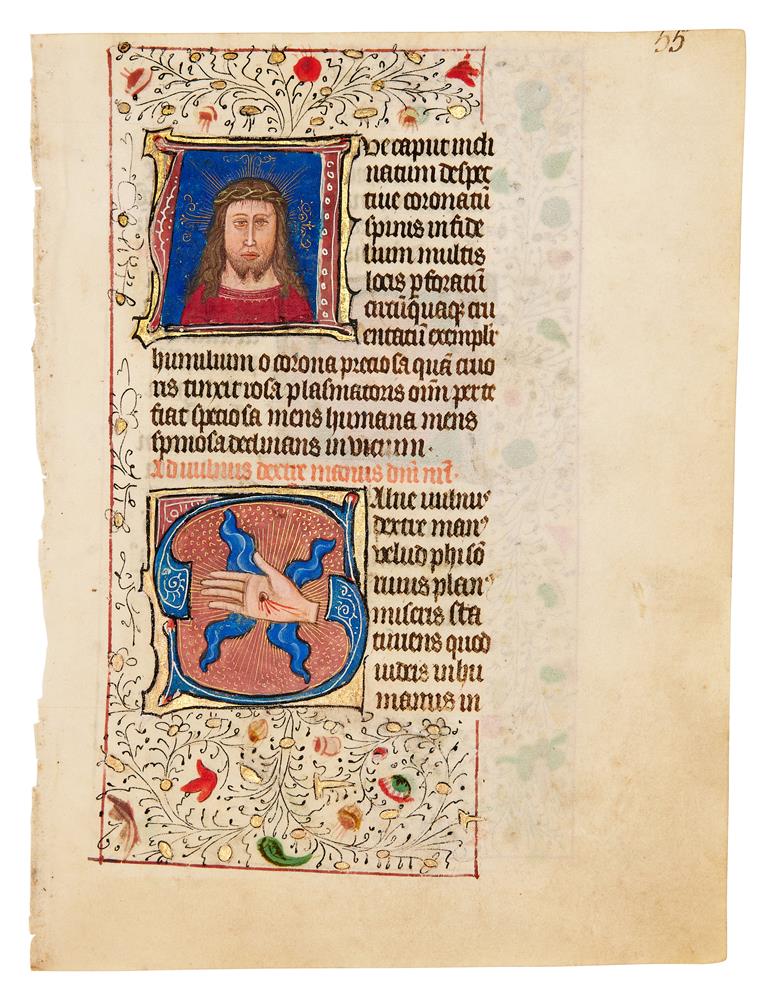SIX LEAVES WITH HISTORIATED AND ILLUMINATED INITIALS BY THE MORGAN 92 GROUP, from the Huth-Hornby-Cockerell-Haddaway Bible, illuminated manuscript on vellum [northern France, probably Paris, first quarter 13th century].
SIX LEAVES WITH HISTORIATED AND ILLUMINATED INITIALS BY THE MORGAN 92 GROUP, from the Huth-Hornby-Cockerell-Haddaway Bible, illuminated manuscript on vellum [northern France, probably Paris, first quarter 13th century]. Six leaves, 220 x 142mm, 55 lines in two columns, written space: 150 x 95mm, SEVEN HISTORIATED AND TEN ILLUMINATED INITIALS (occasional small losses to burnished gold, remnants of adhesive in upper margins). Provenance : from a very grand early 13th-century French bible – the intact manuscript was owned by some of the most famous 20th-century bibliophiles: (1) HENRY HUTH (1815-1878) and ALFRED HENRY HUTH (1850-1910): their sale at Sotheby’s, 15 November 1911, lot 645. (2) C.H. ST. JOHN HORBY (1867-1946), his no 23, by bequest to: (3) SIR SYDNEY COCKERELL (1867-1962). (4) ARTHUR HADDAWAY (1901-1981) exhibited in Gothic and Renaissance Manuscripts from Texas Collections , 1971, at the University of Texas in Austin: sale of his estate at Christie’s New York, 25 September 1981, lot 2. Over 180 leaves of the parent manuscript are now at Ohio State University (Spec.Rar.Ms.Lat.14). The subjects and context of the initials are as follows: (i) historiated initial ‘Q’ with Luke sitting at a lectern, originally f.332v; (ii) historiated initial ‘P’ with St Paul, opening his Letter to the Corinthians, and an illuminated initial ‘P’, originally f. 376; (iii) historiated initial ‘P’ with St Paul, opening his Letter to the Galatians, and an illuminated initial ‘G’, originally f.379; (iv) historiated initial ‘P’ with St Paul, opening his Letter to the Ephesians, and an illuminated initial ‘E’, originally f.381; (v) historiated initial ‘P’ with St Paul, opening his Letter to Philemon; historiated initial ‘P’ with St Paul opening his Letter to the Laodiceans; illuminated initials ‘P’ and ‘I’, originally f. 389; (vi) historiated initial ‘I’ with Jude, opening his Epistle; illuminated initials ‘I’, ‘U’, ‘S’ and ‘G’ and an illuminated initial ‘S’ inhabited by a harp-playing ram, originally f.397. A BRIGHT AND VIBRANT EXAMPLE OF THE STYLE OF THE ROYAL ‘BIBLES MORALISEES’ PRODUCED IN PARIS AT THE BEGINNING OF THE THIRTEENTH CENTURY. The illumination can be attributed to the Morgan 92 Group – so called after a Psalter and Hours for the use of Soissons now in the Morgan Library in New York. The characteristic stylistic features of this group – the figures with long bulbous noses and well-defined nostrils, the fleshy, red-spotted cheeks and the undulating locks – can all be found in the present leaves (see R. Branner, Manuscript Painting in Paris during the Reign of Saint Louis , 1977, pp.58-59).
SIX LEAVES WITH HISTORIATED AND ILLUMINATED INITIALS BY THE MORGAN 92 GROUP, from the Huth-Hornby-Cockerell-Haddaway Bible, illuminated manuscript on vellum [northern France, probably Paris, first quarter 13th century].
SIX LEAVES WITH HISTORIATED AND ILLUMINATED INITIALS BY THE MORGAN 92 GROUP, from the Huth-Hornby-Cockerell-Haddaway Bible, illuminated manuscript on vellum [northern France, probably Paris, first quarter 13th century]. Six leaves, 220 x 142mm, 55 lines in two columns, written space: 150 x 95mm, SEVEN HISTORIATED AND TEN ILLUMINATED INITIALS (occasional small losses to burnished gold, remnants of adhesive in upper margins). Provenance : from a very grand early 13th-century French bible – the intact manuscript was owned by some of the most famous 20th-century bibliophiles: (1) HENRY HUTH (1815-1878) and ALFRED HENRY HUTH (1850-1910): their sale at Sotheby’s, 15 November 1911, lot 645. (2) C.H. ST. JOHN HORBY (1867-1946), his no 23, by bequest to: (3) SIR SYDNEY COCKERELL (1867-1962). (4) ARTHUR HADDAWAY (1901-1981) exhibited in Gothic and Renaissance Manuscripts from Texas Collections , 1971, at the University of Texas in Austin: sale of his estate at Christie’s New York, 25 September 1981, lot 2. Over 180 leaves of the parent manuscript are now at Ohio State University (Spec.Rar.Ms.Lat.14). The subjects and context of the initials are as follows: (i) historiated initial ‘Q’ with Luke sitting at a lectern, originally f.332v; (ii) historiated initial ‘P’ with St Paul, opening his Letter to the Corinthians, and an illuminated initial ‘P’, originally f. 376; (iii) historiated initial ‘P’ with St Paul, opening his Letter to the Galatians, and an illuminated initial ‘G’, originally f.379; (iv) historiated initial ‘P’ with St Paul, opening his Letter to the Ephesians, and an illuminated initial ‘E’, originally f.381; (v) historiated initial ‘P’ with St Paul, opening his Letter to Philemon; historiated initial ‘P’ with St Paul opening his Letter to the Laodiceans; illuminated initials ‘P’ and ‘I’, originally f. 389; (vi) historiated initial ‘I’ with Jude, opening his Epistle; illuminated initials ‘I’, ‘U’, ‘S’ and ‘G’ and an illuminated initial ‘S’ inhabited by a harp-playing ram, originally f.397. A BRIGHT AND VIBRANT EXAMPLE OF THE STYLE OF THE ROYAL ‘BIBLES MORALISEES’ PRODUCED IN PARIS AT THE BEGINNING OF THE THIRTEENTH CENTURY. The illumination can be attributed to the Morgan 92 Group – so called after a Psalter and Hours for the use of Soissons now in the Morgan Library in New York. The characteristic stylistic features of this group – the figures with long bulbous noses and well-defined nostrils, the fleshy, red-spotted cheeks and the undulating locks – can all be found in the present leaves (see R. Branner, Manuscript Painting in Paris during the Reign of Saint Louis , 1977, pp.58-59).







.jpg?w=400)



.jpg)

Testen Sie LotSearch und seine Premium-Features 7 Tage - ohne Kosten!
Lassen Sie sich automatisch über neue Objekte in kommenden Auktionen benachrichtigen.
Suchauftrag anlegen